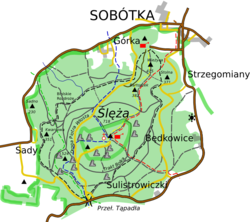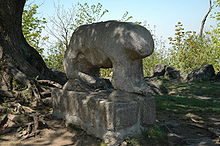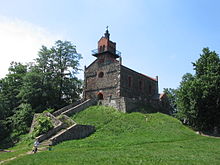- Mount Ślęża
-
Ślęża 
View from north-westElevation 718 m (2,356 ft) Location Location Poland Range Masyw Ślęży Coordinates 50°51′54.061″N 16°42′31.741″E / 50.86501694°N 16.70881694°E Topo map 
Ślęża [ˈɕlɛ̃ʐa] (German: Zobten or Zobtenberg, also Silingi) is a mountain in the Sudetes foothills (Polish: Przedgórze Sudeckie) in Lower Silesia, 30 km (19 mi) from Wrocław, southern Poland. This natural reserve built mostly of granite is 718 m high and covered with forests.
The top of the mountain has a PTTK tourist Mountain hut, a TV and radio mast, church Mary, poorly visible ruins of the castle and observation tower. The mountain and its surrounding region form the protected area called Ślęża Landscape Park.
Contents
Sacred mountain
During the Neolithic Period and at least as far back as the 7th century BC Mount Ślęża (Zobten) was a holy place of the heathen tribes of the Lusatian culture.[citation needed] It was then settled by the Celtic-Germanic Lugians[citation needed] The Silingi, a subpopulation of the East Germanic tribe known as the Vandals are the earliest inhabitants of Silesia known by their name, however the greater part of them moved westwards by the 5th century A.D. and the remainder were slowly replaced in the 6th century by Slavic tribes ("people of the plain").[1] The Silingi were part of the Przeworsk culture[citation needed] The name of the territory Silesia either derives from the Sleza River, or from Mount Ślęża.[2] The hill itself was a religious center of the Silingi, and derives its name from them.[2][3]
The slavic Ślężanie tribe settled in the area when Silesia became a part of Greater Moravia, and then of Bohemia (part of the Holy Roman Empire). Duke Boleslaw I of Poland, a fiefholder of the Holy Roman Empire, conquered Silesia in the 990s, but lost it again to Bohemia, also a part of the empire. As Silencia, recorded by Thietmar of Merseburg, or Silesia, the Latin version, was in earlier German sources written as Slesia, from which developed the High German version Schlesien. Christianity came first via Cyril and Methodius and Regensburg, then in the 10th century Bohemia received a bishopric, Prague, which was subject to the archbishopric of Mainz.
Mount Zobten/Sleza has ancient Germanic holy places dedicated to a sun deity, and remained a holy place during Christian times as well. In the first half of the 12th century, the owner of the place was Danish Peter Wlast Dunin, (Polish: Piotr Włostowic), who founded there an Augustinian convent which was subsequently moved to Wrocław in 1153.
In 1148 the mountain is recorded as Mons Silecii.
Etymology
The Silesians may have been named after the Silingi, though this etymology is disputed; the word is perhaps derived from a Silesian word meaning "wet swampy place".
The current names of the Ślęza river and Mount Ślęża are based on Silesian origins, although the Ślęza is spelled with a standard Z and Mount Ślęża is spelled with a Ż diacritic. Names are based on earlier German documentation as Slesia.
Ślęża in art and culture
Mount Ślęża has been portrayed in the famous but atypical manner of Polish independent film (in Poland called Polskie Kino Niezależne) Edi800 in the movie Ślęża Manekin Project III. More info at: http://www.manekin.org/manekin.html http://www.edi800.org/
Transmitter
On Ślęża there is a facility for FM- and TV-transmission, which uses a 136 metre tall free-standing (with additional guying) lattice tower. The current tower which was built in 1972 replaced a 98 metre tall tower built in 1957, which was partially guyed.
Broadcasts
TV
Programme Frequency No of canals Emission TVP1 Telewizja Polska S.A. 223,25 MHz 12 100 kW TVP2 Telewizja Polska S.A. 503,25 MHz 25 1000 kW POLSAT Telewizja Polsat S.A. 775,25 MHz 59 800 kW TVP3 Wrocław Telewizja Polska S.A. Oddział we Wrocławiu 639,25 MHz 42 800 kW Radio
Programme Frequency Emission power Radio Maryja Prowincja Warszawska Zgromadzenia O.O. Redemptorystów 88,90 MHz 120 kW Radio ZET Radio ZET Sp. z o.o. 93,60 MHz 120 kW PR2 Polskie Radio S.A. 98,80 MHz 120 kW PR3 Polskie Radio S.A. 100,20 MHz 120 kW Radio Wrocław Polskie Radio - Regionalna Rozgłośnia we Wrocławiu "Radio Wrocław" S.A. 102,30 MHz 120 kW Radio ESKA Wrocław Radio ESKA S.A. 104,90 MHz 60 kW See also
References
- ^ T. Hunt Tooley "National Identity and Weimar Germany: Upper Silesia and the Eastern Border", 1997 University of Nebraska Press, ISBN 0-8032-4429-0 p.6 (Google Books)
- ^ a b Adrian Room "Placenames of the World", McFarland 2004m ISBN 0-7864-1814-1 p.333 (Google books)
- ^ Anthony Richard Birley, "Agricola and Germany" 1999, Oxford University Press, ISBN 0-19-283300-6 p.130 (Notes to pages 56-60) (Google books)
External links
- Map of 1600s with Town of Zobten near Zobtenberg (mountain)
- http://radiopolska.pl/wykaz/pokaz_lokalizacja.php?pid=165
Categories:- Silesia
- Mountains of Poland
- Geography of Silesia
Wikimedia Foundation. 2010.




